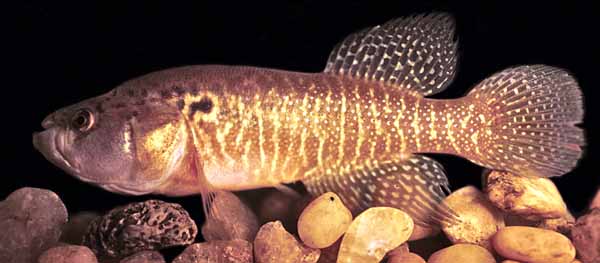Cynolebias oticus
Costa, 2017
|
Familie: Rivulidae
|
 Cynolebias oticus Männchen, Paratypus, UFRJ 9353 -- (C) Costa, W.J.E.M. (2017) in: Zoosystematics and Evolution, 93 (2): 333–341. |
Typen
Holotypus: UFRJ 9437.
Paratypen: BMNH; SMF; UFRJ; ZFMK.
Typusfundort: Brasilien: Temporärer Pool in der Nähe der Straße BR-122, ca. 8 km südlich des Dorfes Pindaí, Mata Veado Flussauen, Rio Verde Einzug, 14°33'39"S, 42°42'10"W (Karte), Höhe 628 Meter ü.d.M.
Etymologie
Vom griechischen oticus (nahe zum Ohr), in Bezug auf die sich fortsezenden otischen und postotischen Serien von Neuromasten, die für die Art diagnostisch sind.
Verbreitung
Cynolebias oticus ist nur aus dem Einzug des Rio Verde bekannt, in der Nähe der Gemeinde Pindaí. Obwohl die Region hochgradig entwaldet wurde, was zum Aussterben einiger sisonaler Killifische geführt hat, welche das Gebiet bewohnt hatten, konnte Cynolebias oticus dort immer noch gefunden werden. Jedoch könnte das gegenwärtig nur noch reduzierte, von dieser Art bewohnte Gebiet vermuten lassen, dass die Art vom Aussterben bedroht ist.
IUCN Status

CR Critically Endangered (vom Aussterben bedroht)
EN Endangered (stark gefährdet)
VU Vulnerable (gefährdet)
NT Near Threatened (potenziell gefährdet)
LC Least Concern (nicht gefährdet)
RE Regionally Extinct (regional oder national ausgestorben)
DD Data Deficient (ungenügende Datengrundlage)
NE Not Evaluated (nicht beurteilt)
Status: Stand 20.10.2017: NE Not Evaluated (nicht beurteilt)
Literatur
- Costa, W.J.E.M. 2014. Six new species of seasonal killifishes of the genus Cynolebias from the São Francisco river basin, Brazilian Caatinga, with notes on C. porosus (Cyprinodontiformes: Rivulidae). Ichthyological Exploration of Freshwaters, 25 (1): 79-96. Zitatseite [: 91, Fig. 6, !!]
- Costa, W.J.E.M. 2017. Description of two endangered new seasonal killifish species of the genus Cynolebias from the São Francisco River basin, Brazilian Caatinga (Cyprinodontiformes, Aplocheilidae). Zoosystematics and Evolution, 93 (2): 333–341. (doi) Zitatseite [: 340, Fig. 5, Foto, Vergleich]